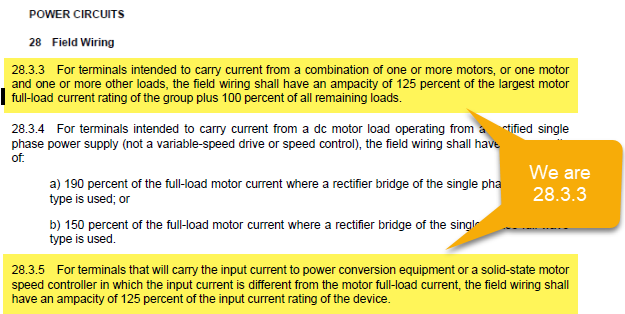I have been working through UL508A but I am having one sticking point where it feels as if UL508A and the NEC conflict.
Specifically, the following excerpts:
NEC:
A couple of things to unpack here, it seems like UL is saying "shall not exceed" and NEC is saying "shall have a rating not less than" when selecting overcurrent protection devices for the feeder.

Specifically, the following excerpts:
NEC:
However in UL508A, section 32.3 on sizing of overcurrent protection, it says430.63 Rating or Setting - Motor Load and Other Load(s)
Where a feeder supplies a motor load and other load(s), the feeder protective device shall have a rating not less than that required for the sum of the other load(s) plus the following:
(1) For a single motor, the rating permitted by 430.52
(2) For a single ... (blah, not applicable)
(3) For two or more motors, the rating permitted by 430.62
32.3.1 The size of the overcurrent protection shall not exceed the ampere value determined from (a) and (b), whichever is larger.
a) The rating of the largest branch circuit protective device in the circuit plus 125 percent of all heater loads plus the full-load currents of all other motors or other loads in the group that could be in operation at the same time; or
b) The ampacity of the conductors or bus bars on the load side of the overcurrent device.
A couple of things to unpack here, it seems like UL is saying "shall not exceed" and NEC is saying "shall have a rating not less than" when selecting overcurrent protection devices for the feeder.
- This seems to conflict? Does anyone have any clarification for this apparent contradiction?
- In 32.3.1, it seems like "shall not exceed the ampere value determined from (a) and (b), whichever is larger" would allow for someone to have an OCPD that is smaller than a), if a) is larger, but larger than what would protect the conductors. This would be violations elsewhere in the standard. What is the point of b)?

